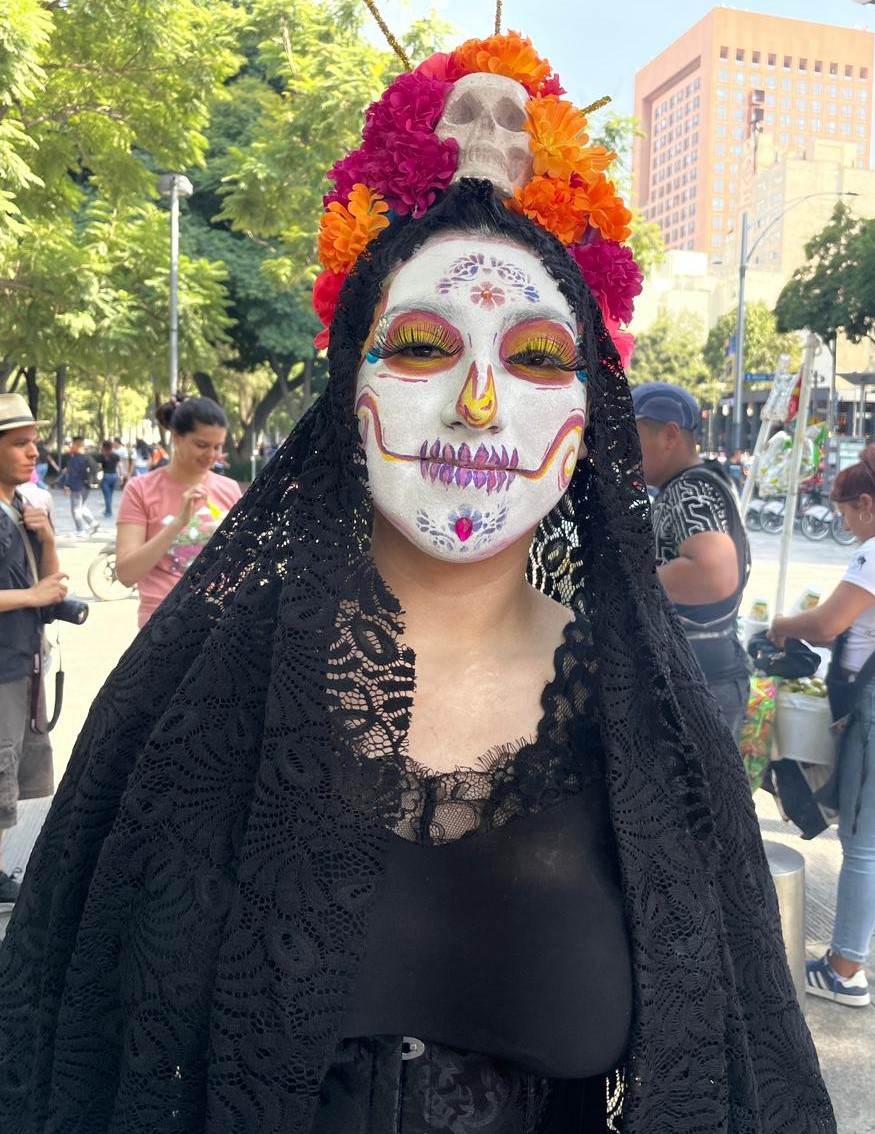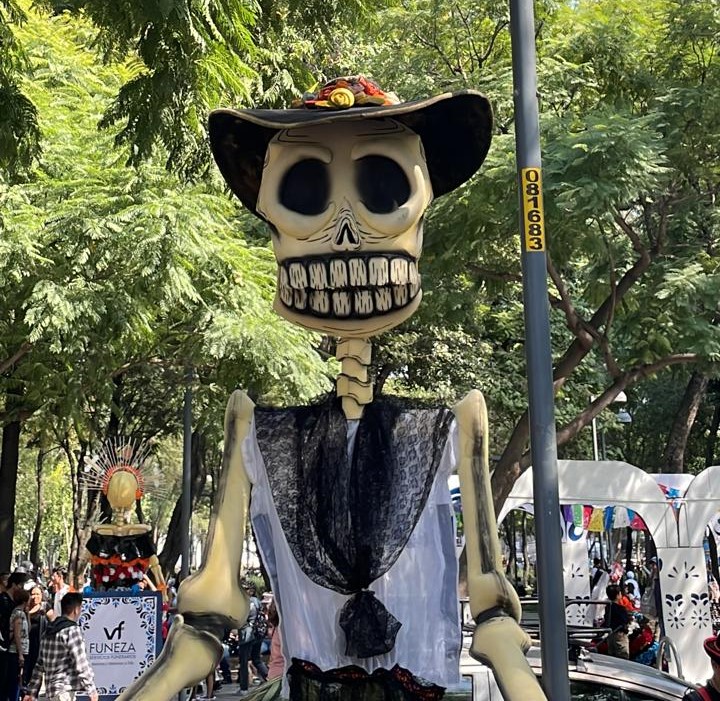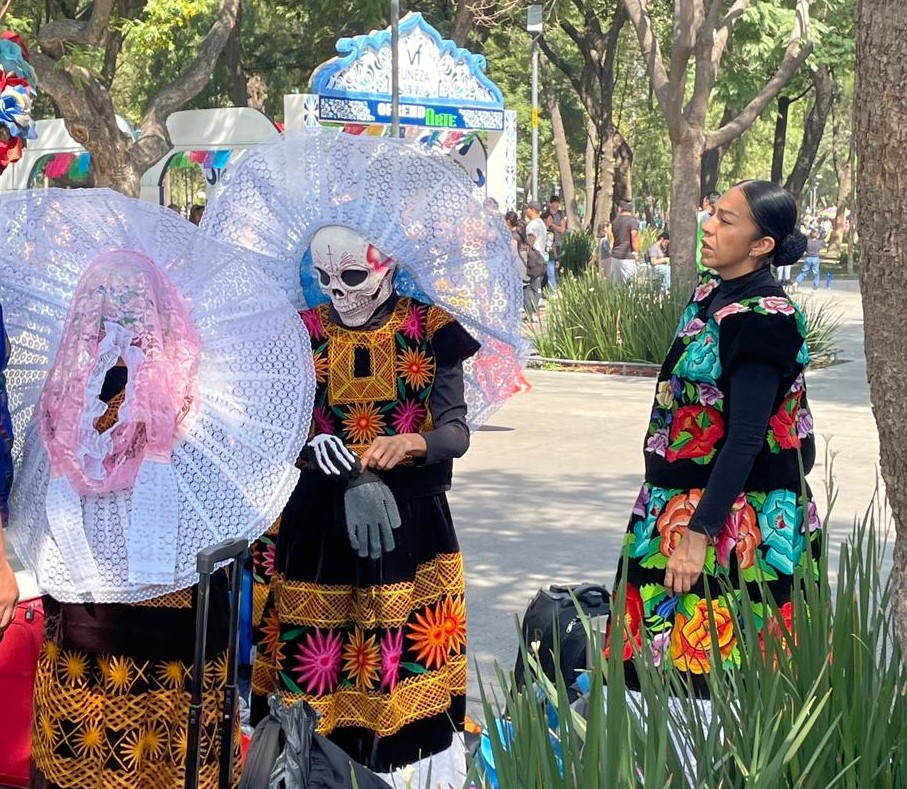THE CATRINA AND THE DAY OF THE DEAD
“Death is democratic, because at the end of the day, whether black, brown, rich or poor, all people end up being skulls”, said the caricaturist José Guadalupe Posada, referring to his most famous character, the Catrina.
The Catrina is an iconic figure of Mexican culture, especially associated with the Day of the Dead. It represents an elegantly dressed skull and is often seen as a satirical representation of death.
The origin of the Catrina goes back to the Aztec figure Mictecacihuatl, the goddess of death. In the legend the Aztec goddess of death kept the bones of the dead, as they could be used at some point. The goddess kept them so that, if needed, they could be used.

The Catrina, as a popular symbol of death, was baptized as such by the muralist Diego Rivera (1886-1957), but he was not the first to include her in his works. He painted her in a beautiful mural called “Sueño de una tarde dominical en la Alameda Central” (Dream of a Sunday Afternoon in the Central Alameda). In his version, La Catrina wears an elegant dress and holds the hand of José Guadalupe Posada, the original creator of the figure.
The renowned Mexican illustrator José Guadalupe Posada (1852-1913) invented the figure of the Catrina in the early 20th century. Posada created the image of an elegant skull dressed in high society clothing, along with a satirical phrase that reads, “La Catrina Garbancera.” The original intention was to criticize the Mexican upper social class of the time who adopted European customs and disdained their indigenous roots. The garbancero was someone who, despite having indigenous blood, pretended to be European and disowned their own culture. They were also called malinchistas. Posada was a social critic and in his works the artist portrayed the injustice that existed during the Porfiriato, a period in which President Porfirio Díaz was in office for up to three decades before the Mexican Revolution took place.
Over time, the figure of La Catrina endured as a symbol of protest and has since become an iconic symbol of the Day of the Dead festival and, more broadly, of Mexican culture. It is a powerful symbol that celebrates life and death at the same time. It represents the richness of Mexican culture and its unique attitude towards death, which differs from that of many other cultures by embracing it with joy and humor. It symbolizes the positive side of death. Where there is death, there was life. It is a way of remembering loved ones who are no longer with us as if it were a celebration. A moment of reunion with your ancestors does not have to be sad.

And of course, the Catrina also has her boyfriend: El Catrín, her eternal lover and faithful party companion in life and death. Every Day of the Dead, they emerge from their tombs in their finery to celebrate life. The elements of their attire are:
- Elegant dress referring to the Victorian Era.
- The hat for women may be adorned with feathers, stones and flowers; the man should wear a classic and elegant cut.
- Stole and gloves.
- High heels for women, shiny shoes for men.
During Day of the Dead celebrations in Mexico, it is common to see representations of La Catrina and the Catrin in the form of sugar skulls, papier-mâché figures and costumes. The idea behind these representations is that, although we all face death, death is a natural part of life, and we should not fear it. The Catrina personifies this idea by presenting death in an elegant and festive way.

The literary calaveritas
But did you know that before the Catrina and the Catrin there were the literary Calaveritas?
Literary skulls, also known as “panteones”, are made up of a series of rhyming verses or epigrams (compositions). are made up of a series of rhythmic verses or epigrams (short poetic compositions that express satirical or witty thoughts). However, what makes them stand out is that their main motif is death seen from the point of view of satire, mischief and irony.
One of the most recognized antecedents of the nature of the calaverita is found in one of the most polemical texts of the Novo-Hispanic period: ‘La portentosa vida de la muerte’ (The portentous life of death) (1792). Authored by the Franciscan Fray Joaquín Bolaños, this text is considered vital for understanding “the aesthetics of death in New Spain”, according to Enrique Flores, an academic specializing in colonial literature.
In Bolaños’ work, a great number of elements are visualized as well as a reading that “alternates the solemn and the funny, the tragic and the comic, the terrible and the grotesque” around a plot in which there is a personification of death as a skeleton that walks among the living and portrays some terrible events of history.
But it would not be until the middle of the 19th century that the literary calaverita as we know it would have its first appearances. One of the oldest publications dates back to 1849 in a critical newspaper called “El Socialista”, edited in Guadalajara, Jalisco, by José Indelicato. The literary skulls published in the printed media were made up of verses criticizing the characters of high society who, by wanting to resemble the European elites, repudiated their own roots. They had their peak during the governments of Sebastián Lerdo de Tejada, Benito Juárez and Porfirio Díaz. The Mexican elite of that time perpetuated denigrating attitudes against the true national identity and its people and imposed customs, traditions and fashions over those native to Mexico.
These calaveritas appeared in the newspapers known as Resistance, adorned by what can be considered the first catrines and catrinas. These were small illustrations with skeletal shapes, but they represented a scene of everyday life, as they sought to reflect the discontent and the conditions in which most of society lived.
Murielle Coppin for Malinali Travel
